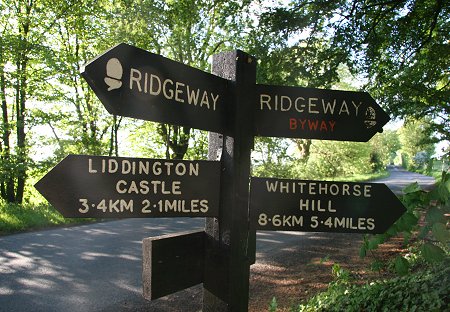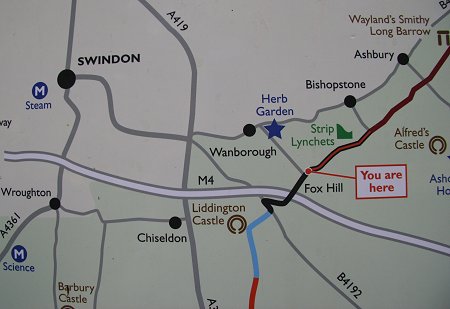The Ridgeway
Britain's historic pathway on Swindon's doorstep
Stone Age man once walked along its route - not only long before the likes of Stonehenge came into being, but even before Britain was an island.
Today it stretches from Overton Hill, near Avebury, in the west, and runs for about 40 miles, crossing the Thames at Streatley. What we now call the Ridgeway Path then continues for another 45-mile section until it reaches Ivinghoe, north east of Aylesbury, following the course of another ancient path (though not quite so ancient as the original Ridgeway) which is called the Icknield Way.
This section is much different in character to the part which runs close to Swindon, passing through beech woodlands, and, strictly speaking, is a continuation of the older Ridgeway. It is all part of a continuous route that once stretched from the south western shores of the English Channel to the North Sea at Hunstanton on The Wash. The Ridgeway is therefore the oldest surviving relic from our human past and Swindon is fortunate to have this remarkable ancient route on its doorstep. It is even more fortunate that the section that transverses the Marlborough Downs and passes up to the Vale of the White Horse is one of the most spectacular of all. As old as the Ridgeway is, however, what remains of it today goes to and from nowhere in particular, calling at nowhere in particular on the way. There is only one village along its route because it lies above the springline, and the Romans - who some may imagine had built it - largely ignored it because it did not connect its major towns. The greatest appeal of the Ridgeway, however, is in its atmosphere. To walkers and cyclists it is like a godsend as large sections of it seem timeless, as does much of the land that is visible from it. Many think of it as an elongated nature reserve where the modern trappings of modern life like the car are largely unwelcome.
Life in a Southern County:
The Ridgeway's qualities were understood and admired by Swindon's two greatest writers, Richard Jefferies (1848-1887) and Alfred Williams (1877-1930). Jefferies talks about the Ridgeway in his 1879 book, Wild Life in a Southern County. A broad green track runs for many a long, long mile across the Downs, now following the ridges, now winding past the foot of a grassy slope, then stretching away through cornfield and fallow. It is distinct from the wagon-tracks which cross it here and there, for these are local only, and if traced up land the wayfarer presently in a maze of field, or end abruptly in the rickyard of a lone farmhouse. It is distinct from the hard roads of modern construction which also at wide intervals cross its course, dusty and glaringly white in the sunshine.
It is not a farm track: you may walk for twenty miles along it over the hills; neither is it the King's highway ... Plough and harrow press hard on the ancient track, and yet dare not encroach upon it. With varying width, from twenty to fifty yards, it runs like a green ribbon ... a width that allows a flock of sheep to travel easily side by side.
Walk the Ridgeway
Probably the most convenient starting point for visitors to the Ridgeway from Swindon - and not least because it has a large car park - is Barbury Castle, the first of a series of Iron Age forts along its route. These magnificent earthworks, surrounded by ditches, are still clearly visible although they are generally believed to have been built approximately 2,500 years ago and abandoned around 1,400 years ago. Barbury Castle stands at 268m (880ft) and overlooks the valley of the River Ray. It covers nearly 12 acres and traces of huts suggest it once had a permanent garrison or village inside the fortifications. Only one known battle took place here - in or around the year AD 556 when the Romanized British inhabitants were defeated by the invading Saxons.
On leaving Barbury Castle, the walker has a choice - whether to follow the ancient route of the Ridgeway (roughly north east) or to continue on the modern Ridgeway Path (roughly due east). The original route skirts Chiseldon, but the modern route, along a section called Smeathe's Ridge, is generally considered to be one of the most attractive stretches in its entire length. It then heads for Ogbourne St George before crossing the A345 and heading back north. It rejoins the old route shortly after passing Liddington Castle, another Iron Age fort. At least as formidable as Barbury, Liddington Castle is slightly higher and commands spectacular views of the Upper Thames. Here the Ridgeway has been buried underneath the modern road that leads over the M4 motorway into the village of Foxhill, which is home to the only pub that actually stands on the Ridgeway, the Shepherd's Rest. About 100 metres further on, the Ridgeway leaves the road behind as it passes Bishopstone, crossing the county boundary from Wiltshire into Oxfordshire as it heads for the Megalithic tomb called Wayland's Smithy, which stands about 50 metres from the path. Local legend has it that if you leave your horse by the tomb along with a coin on the lintel stone, it will be shod by Wayland, the smith of the old Saxon gods. Hence the name. In fact, the tomb was at least two thousand years old by the time the Saxons arrived and may date back as far as 2800 BC, making it even older than the famous West Kennet Long Barrow at the western end of the Ridgeway (close to Silbury Hill). But even the Smithy is overshadowed by the next point of interest along the Ridgeway, Uffington, which has a popular legend, a castle and, of course, its celebrated white horse. The legend belongs to Dragon Hill, the supposed site of St George's slaying of the dragon. The origins of the Uffington White Horse are uncertain, but historians now mostly agree that it is contemporary with the nearby Iron Age castle. What is certain, however, is that this is easily the oldest and most impressive of the 17 in Britain - and a fitting high point at which to leave the Ridgeway as it heads east, away from Swindon. Accommodation on The Ridgeway Two very nice places to stay - or just to enjoy a pint and something to eat - if you are walking the Ridgeway include: The Royal Oak at Bishopstone Michelin-rated for food > The Royal Oak at Bishopstone The White Horse at Woolstone Historic 15th century coaching inn > White Horse at Woolstone |
|
||||||||
|
||||||||
|
||||||||
|
||||||||
|
||||||||
| Ridgeway - National Trail website | ||||||||
















